

Podcasts. Michael Schneider A Beginner's Guide To Constructing the Universe: The Mathematic Archetypes of Nature, Art and Science. W. Bradford Paley: Map of science image in the journal Nature. Update: This has now been published in many more places: the original Nature article, Discover Magazine, SEED, Geo, the Eastern European Edition and India, Brazil, etc., and more books and papers.
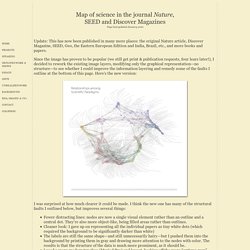
Since the image has proven to be popular (we still get print & publication requests, four lears later!) , I decided to rework the existing image layers, modifying only the graphical representation—no structure—to see whether I could improve the information layering and remedy some of the faults I outline at the bottom of this page. Here's the new version: I was surprised at how much clearer it could be made. I think the new one has many of the structural faults I outlined below, but improves several things: Fewer distracting lines: nodes are now a single visual element rather than an outline and a central dot. What follows is the original posting. The journal Nature chose an image that spatially lays out different areas of science in a plane. Pictorial/communicative inspirations: Current Strengths: We come from the future.
This is, for the most part, an accurate article, except for a few statements.
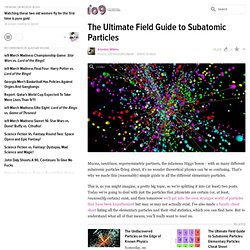
"Exactly what makes a fermion a fermion is a bit complicated, but suffice it to say that fermions are all the particles that deal with matter. So what about the last group of elementary particles, the ones that don't deal with matter? These are the bosons, and they deal with the fundamental forces of the universe. " The statements above can be misinterpreted as suggesting that fermions are defined as particles that deal with matter and bosons are defined as particles that deal with forces. And that is not true.
Particles that deal with matter are fermions and particles that carry the fundamental forces are bosons. What fermions and bosons really are have to do with two apparently unrelated (but actually related) particle properties: spin and statistics. "There are four known bosons" See, this is an example of the misconception I just mentioned. According to special relativity, not general relativity. The Emerald Tablets of Thoth. Esoteric Hebrew Names of God. What is the "best" Hebrew Name of God?

Some of the Jewish sages have said that it is revealed by reciting all 304,805 letters of the Torah in a series. That is, string together all 304,805 letters of the Torah - from the first letter of Bereshit (Bet) through the last letter of Devarim (Lamed) - and "read" this as a single "Word. " Discrete time. Discrete time[edit] Discrete time views values of variables as occurring at distinct, separate "points in time", or equivalently as being unchanged throughout each non-zero region of time ("time period").
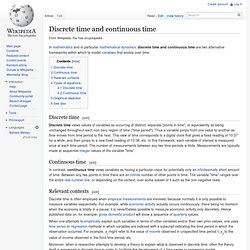
Thus a variable jumps from one value to another as time moves from time period to the next. This view of time corresponds to a digital clock that gives a fixed reading of 10:37 for a while, and then jumps to a new fixed reading of 10:38, etc. In this framework, each variable of interest is measured once at each time period. The number of measurements between any two time periods is finite. Writing Circuits on Graphene. Using a heated atomic force microscope tip, researchers have drawn nanoscale conductive patterns on insulating graphene oxide.

This simple trick to control graphene oxide’s conductivity could pave the way for etching electronic circuits into the carbon material, an important advance toward high-speed, low-power, and potentially cheaper computer processors. Graphene, an atom-thick carbon sheet, is a promising replacement for silicon in electronic circuits, since it transports electrons much faster. What is Magick?
The Tarosophy Tarot Town - A Social Space for Tarot Exchange, Discussion & Sharing. 10 Strange Things About The Universe - Top 10 Lists. Space The universe can be a very strange place.
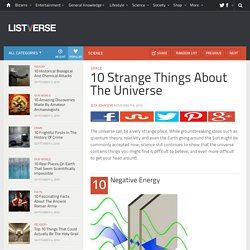
While groundbreaking ideas such as quantum theory, relativity and even the Earth going around the Sun might be commonly accepted now, science still continues to show that the universe contains things you might find it difficult to believe, and even more difficult to get your head around. Theoretically, the lowest temperature that can be achieved is absolute zero, exactly ?
The Zend Avesta, Part I (SBE04) Index. LEEDSKALNIN.COM: MAGNETIC CURRENT RESEARCH. The Inner Life of the Cell. New Physics? Fundamental Cosmic Constant Now Seems Shifty. A fundamental constant of the universe may not be so constant after all, according to a new study.
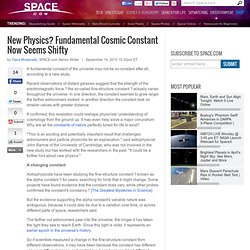
Recent observations of distant galaxies suggest that the strength of the electromagnetic force ? The so-called fine-structure constant ? Actually varies throughout the universe. Watch the Program (Teachers) The Elegant Universe: Part 3 PBS Airdate: November 4, 2003 NARRATOR: Now, on NOVA, take a thrill ride into a world stranger than science fiction, where you play the game by breaking some rules, where a new view of the universe pushes you beyond the limits of your wildest imagination.

Lectures. Alchemical and hermetic emblems 1-20. 8 Wonders of the Solar System, Made Interactive. Computer derives natural laws. Lindsay France/University Photography Professor Hod Lipson and graduate student Michael Schmidt adjust a double pendulum.

Refectors on the pendulum enable motion-tracking software to record position and velocity as the pendulum swings. From this a new computer algorithm can derive equations of motion. If Isaac Newton had had access to a supercomputer, he'd have had it watch apples fall and let it figure out what that meant. But the computer would have needed to run an algorithm developed by Cornell researchers that can derive natural laws from observed data.